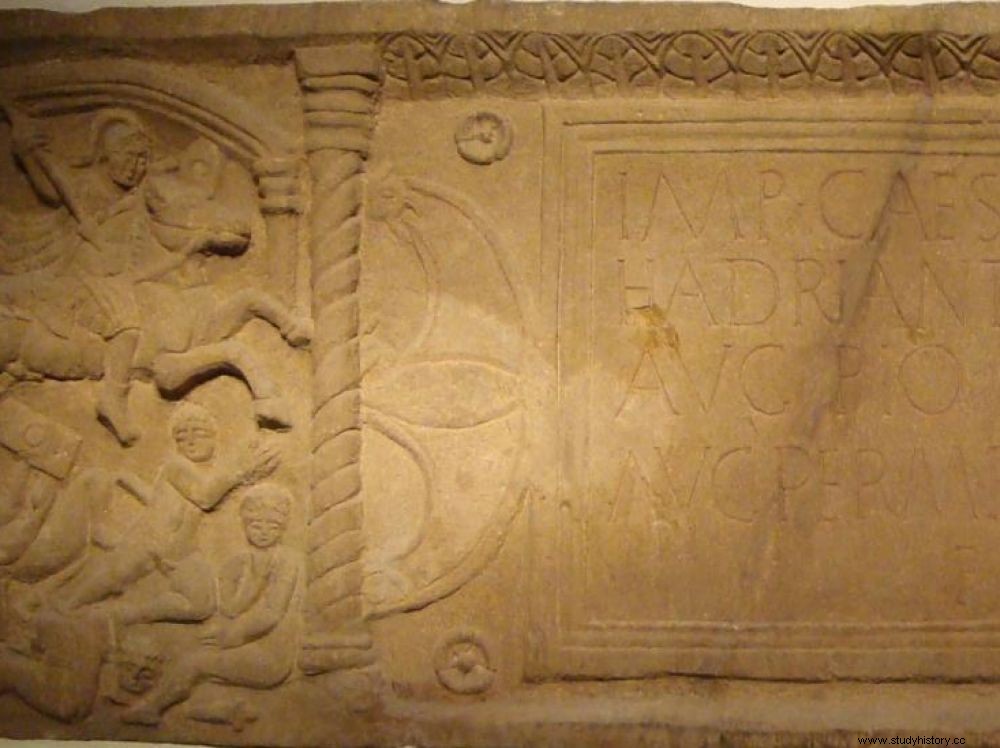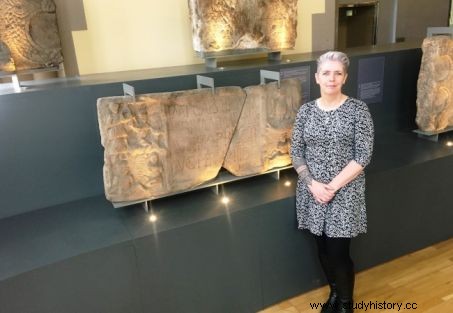Archaeologist Louisa Campbell announced on April 20, 2018 that the distance stones of the Antonine Wall showed traces of polychromy. These traces of color reinforce a very strong iconographic program. The patterns and colors of these sculptures make them real works of propaganda for the New Caledonian barbarians.

Distance Stone from Bridgeness, National Museums Scotland.
Greco-Roman antiquity was a world of color. Far from their present appearance, the pale marble busts, the statues of divinities, the mythological bas-reliefs were painted. And what was true in Rome was also true for the most remote provinces of the empire. Archaeologist Louisa Campbell of the University of Glasgow (Scotland) has x-rayed the distance stone reliefs of the Antonine Wall (large carved and carved slabs where legionnaires dedicate to the Emperor the fraction of the wall that they built). On April 20, 2018, she announced that she had discovered traces of pigments on these stones, a restricted palette of colors dominated by yellow and red. Colors that were to stand out against the green of the Lowlands.
Greco-Roman antiquity was a world of color. Far from their present appearance, the pale marble busts, the statues of divinities, the mythological bas-reliefs were painted. And what was true in Rome was also true for the most remote provinces of the empire. Archaeologist Louisa Campbell of the University of Glasgow (Scotland) has x-rayed the distance stone reliefs of the Antonine Wall (large carved and carved slabs where legionnaires dedicate to the Emperor the fraction of the wall that they built). On April 20, 2018, she announced that she had discovered traces of pigments on these stones, a restricted palette of colors dominated by yellow and red. Colors that were to stand out against the green of the Lowlands.
The Antonine Wall is a fortification built by order of the Emperor Antoninus Pius between the Firth of Forth (the estuary of the River Forth) and the mouth of the River Clyde, Scotland. This wall was intended to protect the empire from the incursion of the Venicones, Verturiones and other Vacomages, the future Pictish peoples. After subjugating the peoples of the region, the legionnaires built this wall of earth and stone 63 kilometers long in a dozen years. They will commemorate the sections they erected on the distance stones, slabs engraved and carved in relief. And painted.
Imperial propaganda without ambiguities
The texts engraved on the twenty surviving distance stones proclaim the name and titles of the emperor. “Father of the country” comes back as a leitmotif. The carved reliefs are more varied. We find emblems of legions, the boar of the 20th century, the capricorn of the 2nd… They also insist on the victory won by the Roman army over the natives. We see Roman horsemen trampling local infantry, or defeated Caledonian warriors kneeling in submission with their hands tied behind their backs. The message is very clear to local people.

Archaeologist Louisa Campbell in front of the Summerston Distance Stone at the Hunterian Museum in Glasgow. Credit:University of Glasgow.
According to Louisa Campbell, "These carvings are propaganda tools used by Rome to demonstrate their power over these and other indigenous groups, this helps the Empire control their borders and it has different meanings for different audiences." The color highlighted by the work of the Glasgow archaeologist underlines and reinforces this message. If yellow hues - orpiment and ocher - are used for clothes and skin, red - color of Mars, god of war - has a more macabre meaning. It is seen on the coats of legionaries, but also on the bodies of Caledonian prisoners, showing them spattered with blood after the battle against Rome. The blood still appears on the beak of an eagle - the bird attribute of Jupiter, the ensign of the Roman legions - as if it had fed on the flesh of its enemies. Probably placed in strategic places near the passageways, these sandstone slabs, now stone-coloured, therefore carried a very strong message, magnified by the coloring. This message was both the assertion of imperial power over the surrounding lands, the reminder of Roman victories and the promise that any rebellion would be put down in blood.
This promise, however, will have no future. Less than a decade after its completion, the Romans abandoned the Antonine Wall and retreated to Hadrian's Wall. This will serve as the border of the Roman Empire until the 5th century AD. The Roman Empire then abandoned the island of Britain to itself before disappearing. The power of Rome had lived. Sic transit gloria mundi .
